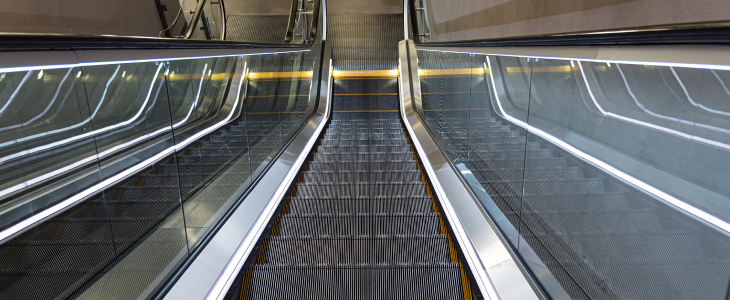Escalators are a common sight in North Dakota’s shopping malls, airports, and public spaces, providing an efficient way to move between different levels. While they are generally safe, escalator-related incidents can occur, leading to personal injury accidents with varying degrees of severity. Understanding the causes, potential injuries, and available legal remedies is essential for those affected by such accidents. If you have been injured in an escalator accident in North Dakota, Pringle & Herigstad can help you.
Common Causes of Escalator Accidents
Escalator accidents can happen for various reasons, ranging from mechanical failures to user behavior. Common causes include:
- Mechanical Malfunctions: Escalators are complex machines with multiple moving parts. Mechanical failures such as broken steps, missing teeth on the escalator chain, or faulty handrails can lead to accidents.
- Poor Maintenance: Negligent maintenance practices can contribute to escalator accidents. Regular inspections and prompt repairs are crucial to ensure the safe operation of these devices.
- Design Flaws: In some cases, accidents may result from inherent design flaws in the escalator system. Issues like uneven steps, inadequate lighting, or insufficient warnings can contribute to injuries.
- User Behavior: Reckless behavior by escalator users, such as running, overcrowding, or improper use of handrails, can lead to accidents. In some cases, user negligence may be a contributing factor.
Potential Injuries from Escalator Accidents
Escalator accidents can result in a range of injuries, from minor bruises to severe, life-altering conditions. Common injuries include:
- Cuts and Abrasions: Entrapment in the moving parts of an escalator can cause cuts and abrasions, especially to extremities such as fingers and toes.
- Fractures and Broken Bones: Falls or entrapment can lead to fractures and broken bones, particularly in vulnerable areas such as wrists, ankles, or hips.
- Soft Tissue Injuries: Sudden stops or jerks on escalators can cause soft tissue injuries, including sprains, strains, and contusions.
- Traumatic Brain Injuries: Severe falls on escalators may result in head injuries, including traumatic brain injuries (TBIs), with long-term consequences.
Liability in Escalator Accident Cases
Determining liability in an escalator accident involves a thorough investigation into the circumstances surrounding the incident. It is important to be aware of who may be potentially liable for the escalator accident as you have the legal right to pursue compensation against such a person or entity for the harm you have suffered. Potential parties at fault may include:
- Property Owners: The owners of the premises where the escalator is located have a responsibility to ensure that it is properly maintained and safe for use.
- Maintenance Companies: If the accident is due to negligent maintenance, the company responsible for servicing the escalator may be held liable.
- Manufacturers: In cases involving design defects or faulty components, the manufacturer of the escalator may be held accountable.
- User Negligence: While less common, escalator users engaging in reckless behavior may share a portion of the liability.
Legal Recourse for Escalator Accident Victims in North Dakota
If you have been injured in an escalator accident in North Dakota, understanding your legal rights is crucial. Taking the following steps can help you seek compensation for the harm you have suffered:
- Seek Medical Attention: Prompt medical attention is essential for your well-being and establishes a record of your injuries. Seek immediate medical attention and comply with doctor-recommended courses of treatment to ensure you properly recover from your injuries. This will also ensure proper documentation of your injuries, symptoms experienced, and course of treatment which will be critical pieces of evidence in any personal injury claim you may pursue.
- Document the Scene: If possible, document the scene of the accident, including any visible hazards, lack of warnings, or malfunctioning components. This may include taking pictures of the scene and writing down your account of what happened while it is still fresh in your mind.
- Gather Witness Information: Collect contact information from any witnesses who may have observed the incident. Witnesses can work to corroborate your account of what happened.
- Preserve Evidence: Preserve any relevant evidence, such as clothing, photographs, or damaged personal belongings. Keep these items safe and organized so they can be accessed when needed. These are things that can be critical in supporting your case.
- Consult with an Attorney: Engage the services of an experienced personal injury attorney who can assess the details of your case, identify liable parties, and guide you through the legal process.
Contact Our Escalator Accident Attorneys in North Dakota
Escalator accidents can have serious consequences for victims, both physically and emotionally. If you or a loved one has been injured in an escalator accident in North Dakota, it’s crucial to understand your legal rights and options. Seeking the assistance of an experienced personal injury attorney can help you navigate the complexities of the legal system, pursue compensation for your injuries, and hold responsible parties accountable for their negligence. Remember, you have the right to a safe environment, and those responsible for your injuries should be held to account. The trusted personal injury team at Pringle & Herigstad is here to fight for you. Contact us today.
Pringle & Herigstad, P.C. is committed to supporting individuals in North Dakota, including Grand Forks and Minot, as well as the surrounding areas, who have suffered injuries in an escalator accident. Our dedicated team is here to provide legal assistance and guidance to those facing the complex challenges that arise from these incidents.
